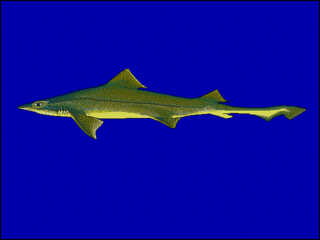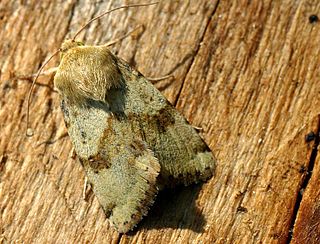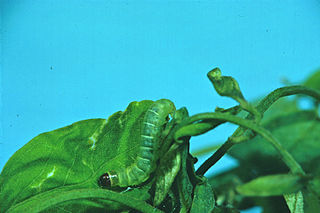Related Research Articles

Mythimna ferrago, the clay, is a moth of the family Noctuidae. The species was first described by Johan Christian Fabricius in 1787. It is distributed throughout Europe and is also found in Morocco, Algeria, Turkey, Asia Minor, Armenia, Syria, Turkestan, Israel, Lebanon, Iraq, Iran, Central Asia and the western parts of temperate North Asia. Also Tibet.

Appias indra, the plain puffin, is a small butterfly of the family Pieridae, that is, the yellows and whites, which is found in south and southeast Asia.

The speckled smooth-hound is a houndshark of the family Triakidae. It is found on the continental shelf of the eastern Pacific, between latitudes 0° and 54° S, at depths between 16 and 50 m. It can reach a length of 130 cm (51 in). Collectively with certain other species of shark, it is known as "tollo".

The spot-winged wood quail is a species of bird in the family Odontophoridae. It is found in Brazil, Argentina and Paraguay, and formerly in Uruguay. Its natural habitats are subtropical or tropical dry lowland forests. Its population is thought to be declining but at a moderate rate, so the International Union for Conservation of Nature has assessed it as being a "least-concern species".

Picumnus is a large genus of piculets. With a total length of 8–10 cm (3–4 in), they are among the smallest birds in the woodpecker family.

Heliothis viriplaca, the marbled clover, is a moth of the family Noctuoidea. It is found in Europe and across the Palearctic to Central Asia then to Japan, Korea and Sakhalin. In the south, it penetrates to Kashmir and Myanmar. As a migratory moth, it also reaches areas in northern Fennoscandia in some years. North of the Alps, both indigenous and immigrant individuals occur in certain areas. The heat-loving species occurs mainly on dry grasslands, fallow land, heathlands and sunny slopes and slopes and the edges of sand and gravel pits.

Utetheisa pulchella, the crimson-speckled flunkey, crimson-speckled footman, or crimson-speckled moth, is a moth of the family Erebidae. The species was first described by Carl Linnaeus in his 1758 10th edition of Systema Naturae.

Achlya flavicornis, the yellow horned, is a moth of the family Drepanidae. The species was first described by Carl Linnaeus in his 1758 10th edition of Systema Naturae. It is found from Europe to the eastern Palearctic ecozone.

Agonopterix robiniella, the four-dotted agonopterix moth or locust leaf roller, is a moth of the family Depressariidae. It is found in North America, where it has been recorded to appear in places from Nova Scotia to Georgia, west to Oklahoma, north to Illinois, Michigan and southern Ontario.

Neoclanis is a genus of moths in the family Sphingidae, containing one species, Neoclanis basalis, which is known from dry bush and woodland from Zimbabwe and Angola to Zambia, Tanzania and eastern Kenya.

Catochrysops strabo, the forget-me-not, is a small butterfly found in Asia that belongs to the lycaenids or blues family. The species was first described by Johan Christian Fabricius in 1793. It is found in Sri Lanka, India, from Sikkim to Indochina and in Sundaland, Sulawesi and the Philippines.
Alucita flaviserta is a species of moth of the family Alucitidae. It is known from Mozambique.

Hypena labatalis is a species of moth of the family Erebidae first described by Francis Walker in 1859. It is found in Australia, India and Sri Lanka.
Rhopalosetia is a monotypic moth genus in the family Copromorphidae. Its only species, Rhopalosetia phlyctaenopa, is found in French Guiana. Both the genus and species were first described by Edward Meyrick in 1926.
Nidara marcus is a moth in the family Drepanidae. It was described by Watson in 1965. It is found in Madagascar.
Negera bimaculata is a moth in the family Drepanidae. It was described by William Jacob Holland in 1893. It is found in Cameroon, Gabon, Ghana and Liberia.
Spidia inangulata is a moth in the family Drepanidae. It was described by Watson in 1965. It is found in Cameroon and Nigeria.
Cathegesis angulifera is a moth in the family Gelechiidae. It was described by Walsingham in 1897. It is found on the West Indies.
Chlamydastis crateroptila is a moth in the family Depressariidae. It was described by Edward Meyrick in 1918. It is found in French Guiana.

Papaipema impecuniosa, also known as the aster borer moth or impecunious borer, is a moth in the family Noctuidae. It is found in eastern North America, where it ranges from Nova Scotia to Georgia, west to Illinois and north to Wisconsin and Ontario.
References
| This article on a moth of the subfamily Symmocinae is a stub. You can help Wikipedia by expanding it. |